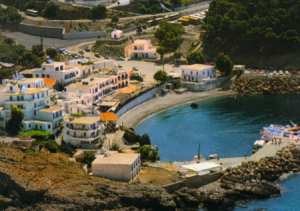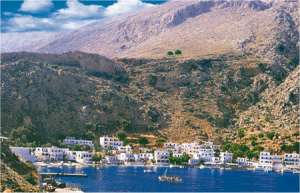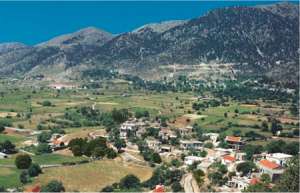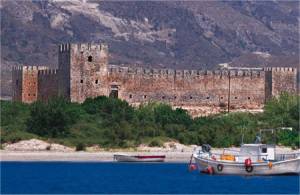|
Sfakia-Fragokastello
Sfakia
Due to its geographic position, is isolated from the rest
of Crete, on the steep shores of the Lybian Sea.  Also
known for playing a key role in the revolution and liberation
of the island and for its resident heroism. Today, it is a
picturesque large village, built amphi-theatrically above
the harbour. There are no indications of habitations in ancient
times. Only the Venetian castle of the 15th and 16th centuries
survives; it was called Sfakia or Sfachia and thus the entire
province took its name. The fortress was used as the residence
of the Providore, (administrative leader in the years of Venetian
dominion). It was renovated and used by the Turks. Owing to
the barren soil the inhabitants main occupation was navigation
and commerce. Worth visiting are the temples of Agios Georgios
(St George) and Agion Panton, which have remarkable murals.
You can get there by suburban bus service (KTEL) from Chania
or by car if you take the road to Sfakia. (72 km South of
Chania). From Sfakia you can return to Chania by bus, where
you will also cross Imbros gorge and the beautiful plateau
of Askifou, circling around the White Mountains of Crete. Also
known for playing a key role in the revolution and liberation
of the island and for its resident heroism. Today, it is a
picturesque large village, built amphi-theatrically above
the harbour. There are no indications of habitations in ancient
times. Only the Venetian castle of the 15th and 16th centuries
survives; it was called Sfakia or Sfachia and thus the entire
province took its name. The fortress was used as the residence
of the Providore, (administrative leader in the years of Venetian
dominion). It was renovated and used by the Turks. Owing to
the barren soil the inhabitants main occupation was navigation
and commerce. Worth visiting are the temples of Agios Georgios
(St George) and Agion Panton, which have remarkable murals.
You can get there by suburban bus service (KTEL) from Chania
or by car if you take the road to Sfakia. (72 km South of
Chania). From Sfakia you can return to Chania by bus, where
you will also cross Imbros gorge and the beautiful plateau
of Askifou, circling around the White Mountains of Crete.
Anopolis
Another historic village, built near the ancient town of the
same name, at an altitude of 600m on the slopes of the White
Mountains of Crete, with a nice view to the Lybian sea. Cyclopian
walls of pelasgic origin survive in the settlement Riza. It
was well-known during the Hellenistic period, but it flourished
chiefly during the Roman and Byzantine period. In the first
centuries of Venetian dominion, Anopolis was the centre of
resistance against the Venetians. After 1365 and the repression
of the rebellion of Kalergi, the entire village was demolished
and the inhabitants spread out to other districts. In addition
Anopolis played an important role in the 1770 revolution against
Turks, with Ioannis Daskalogiannis as leader. The revolt was
a failure, and as a result the area of Anopolis-Sfakia was
under even harder Turkish occupation. Worth visiting is the
church of Agios Georgios (St. George's) where Ioannis Daskalogiannis
raised the flag of the revolution in March 1770. Worth visiting
also is the Aradenas Gorge, which is very steep and imposing
with its wild natural beauty. Crossing the gorge is difficult
but beautiful. You can get there by suburban bus service from
Chania (KTEL) or by car car if you take the road to Sfakia.
 Aradena Aradena
On the western side of the homonymous gorge we find the deserted
village of Aradena. Here existedthe ancient town Aradin or
Iradin, ruins of which survive near the village. It is believed
that it was founded by Phoenicians. Its name is related to
the Phoenecian word Aruad, which means refuge. A homonymous
city existed also in Phoeniki.
Loutro
Between Agia Roumeli and Sfakia it is worth visiting the small
seaside picturesque village Loutro. Here used to be the ancient
town Phinikas, port of Anopolis. The foundations of buildings
and vaulted reservoirs survive up to now. You can reach Loutro
only by motor boat from Sfakia.
Askifou
A very picturesque and beautiful plateau which is composed
by many neighbourhoods. On the plateau where the village is
built there is a Turkish castle. The area has a beautiful
wild cypress forest.  The
plateau is surrounded by the highest peaks of Lephka Ori (White
Mountains), it is believed that in this place used to be a
lake! Askifou is also a historic area because of its role
during the revolution against Turkish rule. Worth visiting
is the Imbrou gorge, which starts in Askifou and ends at the
sea. The walk is possible and the view from the footpath,
as you walk towards Sfakia is breathtaking. You can get there
by suburban bus service (KTEL) from Chania or by car if you
take the road towards Sfakia (48 km South-East of Chania). The
plateau is surrounded by the highest peaks of Lephka Ori (White
Mountains), it is believed that in this place used to be a
lake! Askifou is also a historic area because of its role
during the revolution against Turkish rule. Worth visiting
is the Imbrou gorge, which starts in Askifou and ends at the
sea. The walk is possible and the view from the footpath,
as you walk towards Sfakia is breathtaking. You can get there
by suburban bus service (KTEL) from Chania or by car if you
take the road towards Sfakia (48 km South-East of Chania).
Fragokastello
A village with vast, beautiful beaches, next to an impressive
fort built by Venetians in 1371, which gives an idyllic setting.
The shape of the fort is rectangular with a square-shaped
tower at each corner. On its gate there is a relief of the
lion of St. Mark and on the left and right Venetian crowns.
The inner buildings and the loopholes are constructed by the
Turks.  Under
the building there are vestiges of the church of St Mark.
The history of Fragokastello is filled with bloody battles
and even today, residents speak of ghosts, spirits of dead
warriors called "Drosoulites" who appear in May or June of
every year. One possible explanation of this phenomenon is
that it is a mirage. Worth visiting are the Venetian fort
and the "Orthi Amo" beach with many sandy steep hills. You
can get there by suburban bus service (KTEL from Chania of
by car if you take the road to Sfakia. (80 km South-East of
Chania). Under
the building there are vestiges of the church of St Mark.
The history of Fragokastello is filled with bloody battles
and even today, residents speak of ghosts, spirits of dead
warriors called "Drosoulites" who appear in May or June of
every year. One possible explanation of this phenomenon is
that it is a mirage. Worth visiting are the Venetian fort
and the "Orthi Amo" beach with many sandy steep hills. You
can get there by suburban bus service (KTEL from Chania of
by car if you take the road to Sfakia. (80 km South-East of
Chania).
|
